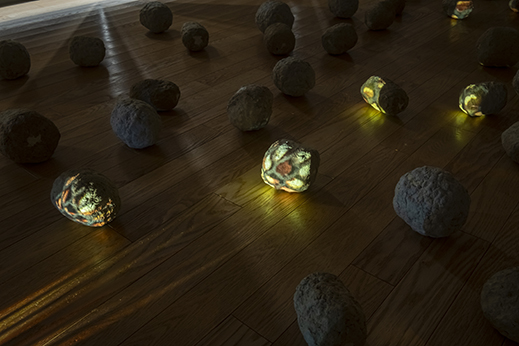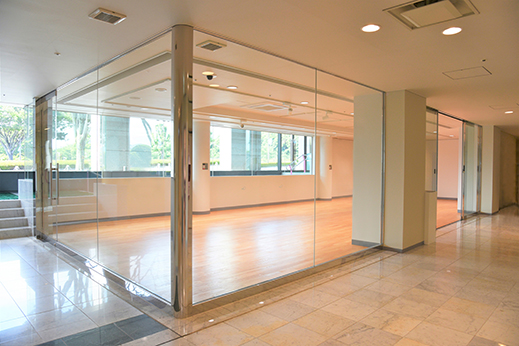| |
|
Here and There introduces art, artists, galleries, museums, and other cultural facilities around Japan that non-Japanese readers and first-time visitors may find of particular interest.
|
|
 |
|
|
 |
 |
Spirits in the Material World: The Paper Art of Reiko Nireki
Alan Gleason |
 |
Installation view, Where the soul is (2022), with slide projection. Photo courtesy of Fuji Paper Art Museum |
Ghostly, featureless figures huddle at one end of a long, dimly lit gallery. A bit larger than human beings, they call to mind burka-clad women, Egyptian sarcophagi, or giant cocoons. Bathed in the light of a slide projector, the objects reflect a shifting panorama of landscapes, ancient statuary, marketplaces, grazing cattle.
The artist, Reiko Nireki, explains that the images are of India, a country she has visited on several occasions. The looming, hollow, vaguely anthropomorphic shapes are sculptures she has made by applying a mash of recycled paper pulp over a frame of wire or bamboo. Among their inspirations, she says, are the trunks of the great sacred trees of the world, and the large clay burial urns of Japan's prehistoric Jomon people.
Installation view, Where the soul is (2022). Sculptures (1995): recycled paper pulp, jute. Photo courtesy of Fuji Paper Art Museum |
Until 21 March, seven of these enigmatic figures are on display at the Fuji Paper Art Museum in Fuji, a city nestled between its namesake mountain and Suruga Bay. Accompanying the large sculptures are a scattering of hollow papier-mâché "rocks" containing pebbles that rattle like percussion instruments when one picks these objects up, as visitors are encouraged to do. (They are also invited to climb inside the sarcophagus-like sculptures, which have apertures of various sizes on the side or top.) Titled Where the soul is, the entire array is an installation that fills the museum's gallery space.
 |
|
Close-up view of "rocks" in Where the soul is (2022), with slide projection. Photo courtesy of Fuji Paper Art Museum |
The exhibition represents something of a homecoming for Nireki, who was born in Izu, just across the bay from Fuji, but only recently returned to the area after many years living abroad or elsewhere in Japan. From 1999 to 2018 she made her home in rural Tokushima on the island of Shikoku, where she rented a former sake brewery spacious enough to accommodate more than 30 of her sculptures. Now that she has vacated the brewery and moved back to Shizuoka Prefecture, however, she must find a place to store these works or get rid of them altogether. Viewers will immediately understand that this would be a terrible loss.
Where the soul is sculptures at Reiko Nireki's studio in an old sake brewery, Awa, Tokushima (2018). Photo © Reiko Nireki |
Nireki did not always sculpt with paper, nor did she begin with a formal education in the plastic arts. An English literature major in college, she first tried her hand at clay sculpture in her twenties. Frustrated that clay lent itself too readily to figurative forms, she soon began looking for a medium that was "simpler and stronger," and discovered paper when she took a washi workshop in Tokushima and became a paper artist's assistant. At 30 she decided she wanted more formal art training -- and traveled to England, then Germany, to get it. Nireki explains that the move was inspired by a love of the English language and of European art, as well as dissatisfaction with Japanese pedagogic methods. "In Europe, the students ask questions -- in Japan they don't."
While in Europe she made her first sculptures from recycled paper pulp. She also met her husband, Hiroshi Mikami, a globetrotting sculptor and fellow Japanese who had been organizing a sculpture symposium in India. In 1996 they returned together to Japan, where Nireki began sculpting with the same kozo mulberry fiber used in washi, and quickly found her work to be in demand. Her first solo exhibition of these sculptures -- the same ones that appear in the Fuji show -- was in 1997 at Tokyo's Sagacho Exhibit Space, one of the country's first galleries devoted to contemporary art. Since then Nireki has used that inaugural show's title, Where the soul is, for subsequent presentations of this body of work over the years. The sculptures also found favor as stage sets, notably in the productions of avant-garde playwright Shogo Ota.
 |
|
Sculptures by Reiko Nireki on stage in a performance of The Water Station 3 by Shogo Ota at the Setagaya Public Theater (1998). Photo by Gen'ichiro Ota |
Things seemed to be on a roll for Nireki in her home country until her husband suddenly died of cancer in 1999. For some time, she says, she lost her desire to make art, but was rejuvenated by travel abroad. Applying for artist-in-residence programs in such far-flung parts of the world as Finland, Brazil, and the U.S., she gained the confidence to create opportunities to pursue her muse in diverse environments. Meanwhile she maintained her base in the sake brewery in Tokushima.
Another Landscape (2021), two-layer painting, indigo ink on paper. Photo © Reiko Nireki |
Throughout her career, paper has remained Nireki's material of choice, but she has expanded her oeuvre from three-dimensional objects to paintings. Another Landscape is a series of forest and mountain scenes in indigo ink or watercolor, painted on double or triple layers of paper. This adds a quality of depth to the landscapes, while the paper's translucence allows them to glow when hung in front of a window in natural light.
Light objects, recycled washi fiber on bamboo structures, in the artist's studio, Awa, Tokushima (2016). Photo © Reiko Nireki |
In recent years Nireki has also been creating what she calls "light objects" -- large, irregular spheres made of recycled washi fiber applied to a bamboo frame. Whether arranged on the floor of a gallery or on the stage of a traditional joruri puppet theater production, they resemble boulders of molten lava -- brimming with primal energy, yet deeply meditative. The sight needs to be seen firsthand, and one hopes that these works will be given a show of their own sometime. Along with Nireki's larger sculptures, they also deserve a permanent home.
Light objects at the Ningyo Joruri Theater, Awa Jyurobei Yashiki, Tokushima (2018). Photo © Reiko Nireki |
The city of Fuji is an appropriate host for a Paper Art museum (and the first in Japan devoted to the art at that, according to museum director and sculptor Yuji Urushibata). Fuji is Japan's "paper capital," best known perhaps for the belching stacks of the paper mills that bullet-train passengers whip past on their way between Tokyo and Nagoya. But it also boasts one of the most stunning backdrops of any city anywhere -- the titular peak soars straight up behind it.
A recent addition to Fuji's cultural offerings, the museum opened in 2016 in the new Rosé Theatre building, located downtown across from a large park. Funded by the city, it features four exhibitions a year that highlight the often sublime artistic uses to which paper can be put. Easily accessed by expressway or bullet train, the Fuji Paper Art Museum makes for a worthwhile day trip from Tokyo, with some stunning views in the bargain.
 |
|
The gallery of the Fuji Paper Art Museum, on the first floor of the Rosé Theatre building in downtown Fuji city. |
All works shown are by Reiko Nireki; all photos are courtesy of the artist or the Fuji Paper Art Museum.
|
 |
| Reiko Nireki exhibition: Where the soul is |
| 4 January - 21 March 2022 |
| Fuji Paper Art Museum (in Japanese only) |
Rosé Theatre 1F, 1750 Tadehara-cho, Fuji, Shizuoka
Phone: 0545-32-6581
Open 10 a.m. to 6 p.m.; closed 14 and 15 March 2022
Access: 15 minutes by bus from Shin-Fuji Station on the JR Tokaido Shinkansen (1 hour from Tokyo) or Fuji Station on the JR Tokaido Line; 2.3 km by car from the Tomei Expressway Fuji Interchange; parking available
|
| Reiko Nireki |
|
|
|
| |
 |
Alan Gleason
Alan Gleason is a translator, editor and writer based in Tokyo, where he has lived for over 30 years. Since 2006 he has edited artscape Japan and written the Here and There column, as well as translating the Picks reviews. He also edits and translates works on Japanese architecture, music, and theater. |
|
|
|
|
|
|
|
|
|
 |
|